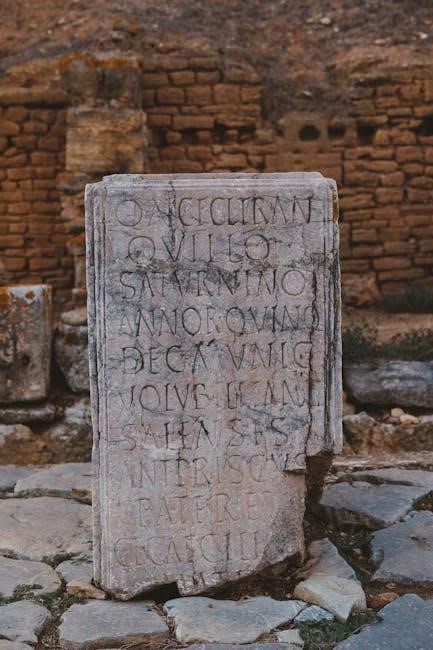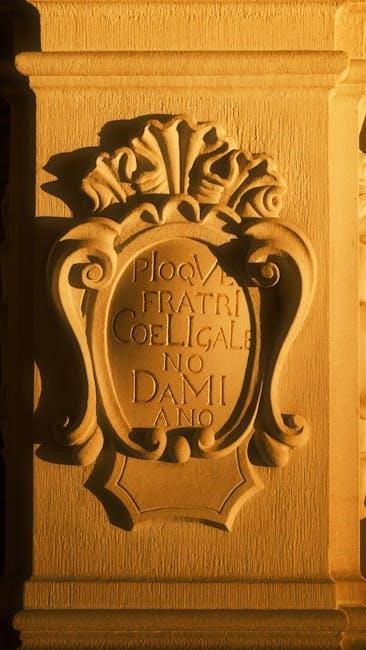The Traditional Latin Mass, also known as the Tridentine Mass, is a form of the Roman Rite liturgy that dates back centuries. Its text, rooted in ancient traditions, has been preserved and celebrated by many faithful Catholics worldwide. The availability of PDF resources, such as missals and booklets, has made it easier for the faithful to participate fully in the liturgy. These documents often include the Latin text alongside English translations, aiding in understanding and devotion. The transition from Latin to vernacular languages in the 1960s sparked discussions, but the Latin Mass remains a cherished part of Catholic heritage, with many still opting for its solemnity and historical significance.
Purpose
The purpose of the Latin Mass text in PDF format is to provide a comprehensive and accessible resource for the faithful to participate fully in the Traditional Latin Mass. These documents are designed to assist both the congregation and the clergy in understanding and celebrating the liturgy according to the ancient rites of the Roman Catholic Church. The PDFs typically include the complete text of the Mass in Latin, often accompanied by English translations, as well as rubrics, or instructions, for the proper celebration of the liturgy. This ensures that the faithful can follow the Mass with devotion and precision, whether they are attending a Low Mass or a High Mass.

The primary goal of these PDF resources is to foster a deeper understanding and appreciation of the Traditional Latin Mass, which has been a cornerstone of Catholic worship for centuries. By providing the authentic text of the Mass, these documents help to preserve the liturgical traditions that have been passed down through generations. They also serve as an educational tool, enabling both priests and laypeople to learn about the history, structure, and spiritual significance of the Mass.
Moreover, the PDF format allows for easy distribution and accessibility, making it possible for individuals to download and print the texts for personal or communal use. This is particularly useful for those who may not have access to physical missals or who wish to familiarize themselves with the liturgy before attending a Traditional Latin Mass. The inclusion of musical settings and chants in some PDFs further enhances the ability of the faithful to participate actively in the liturgical celebration.

Ultimately, the purpose of the Latin Mass text in PDF format is to support the spiritual lives of the faithful by providing a reliable and accessible means of engaging with the Traditional Latin Mass. These resources are invaluable for anyone seeking to deepen their understanding of the liturgy and to participate more fully in the sacred rites of the Church.

Overview
The Latin Mass text in PDF format is a valuable resource for those seeking to engage with the Traditional Latin Mass, also known as the Tridentine Mass. These documents typically contain the complete liturgical texts, prayers, and rubrics necessary for the celebration of the Mass according to the 1962 Roman Missal, which is the standard for the Extraordinary Form of the Roman Rite. The PDFs are often designed to be user-friendly, allowing individuals to easily follow along with the liturgy, whether they are attending a Low Mass or a Solemn High Mass.
One of the key features of these PDF resources is the inclusion of both the Latin text and its English translation, side by side. This bilingual format enables the faithful to deepen their understanding of the liturgy by comparing the original Latin with its English counterpart. Additionally, many PDFs include musical settings for the chants and hymns that are integral to the Traditional Latin Mass, further enriching the worship experience.

The structure of the PDFs generally follows the order of the Mass, beginning with the Introit and progressing through the Kyrie, Gloria, Collect, Epistle, Gospel, Offertory, Preface, Canon, Communion, and Postcommunion. These sections are meticulously laid out, often with clear indications of when the faithful should kneel, stand, or participate vocally. Some PDFs also include explanatory notes and rubrics, which provide guidance on the proper posture, gestures, and responses expected during the Mass.
Furthermore, the PDF format allows for easy distribution and accessibility, making it possible for individuals to download and print the texts for personal or communal use. This is particularly beneficial for those who may not have access to physical missals or who wish to familiarize themselves with the liturgy before attending a Traditional Latin Mass. The widespread availability of these PDFs has played a significant role in the resurgence of interest in the Extraordinary Form of the Mass, particularly among younger generations and those seeking a deeper connection to the Church’s liturgical heritage.

Form
The Latin Mass text in PDF format is structured to reflect the traditional liturgical norms of the Roman Rite, adhering to the 1962 Missale Romanum. These documents are meticulously organized to ensure that the prayers, chants, and rubrics are presented with clarity and precision. The form of the Mass is divided into two main parts: the Ordinary and the Proper. The Ordinary consists of texts that remain constant throughout the liturgical year, such as the Kyrie Eleison, Gloria in Excelsis, Credo, Sanctus, and Agnus Dei. These sections are often highlighted in the PDFs, making it easier for the faithful to follow the liturgy.
The Proper, on the other hand, includes texts specific to particular days or seasons, such as the Introit, Collect, Epistle, Gospel, Offertory, and Communion. These vary depending on the feast day or liturgical season and are carefully included in the PDFs to ensure the faithful can participate fully. Many PDFs also incorporate rubrics, which provide detailed instructions on the actions of the priest, deacon, subdeacon, and servers, as well as the posture and responses of the congregation.
Musical settings are often integrated into the PDFs, particularly for the chants and hymns that accompany the Mass. These include the Gregorian chant notation for the Introit, Gradual, Alleluia, and other musical elements, allowing the schola or choir to sing the Mass in its traditional form. Some PDFs also feature polyphonic arrangements for the Ordinary of the Mass, further enriching the liturgical experience.
The PDFs are typically formatted to mimic the layout of traditional missals, with the Latin text on one side and its English translation on the other. This bilingual format facilitates understanding and devotion for those who may not be fluent in Latin. Additionally, many resources include explanatory notes and instructions for the laity, helping them to engage more deeply with the liturgy.

Structure
The Latin Mass text PDF is organized into the Ordinary and Proper sections. The Ordinary includes fixed prayers like the Gloria and Credo, while the Proper contains variable texts for specific days. Rubrics guide liturgical actions, and musical notations are provided for chants. The PDFs often feature bilingual layouts, with Latin and English texts side by side, ensuring accessibility for all worshippers while preserving tradition.
Ordinary
The Ordinary of the Latin Mass refers to the fixed texts and prayers that remain the same for every celebration of the Mass, regardless of the specific day or feast. These include essential parts such as the Kyrie Eleison (Lord, have mercy), Gloria in excelsis Deo (Glory to God in the highest), Credo (Nicene Creed), Sanctus (Holy, Holy, Holy), Benedictus (Blessed is he who comes), and Agnus Dei (Lamb of God). These prayers are foundational to the structure of the Mass and are often included in Latin Mass PDFs alongside their English translations to facilitate participation by the faithful.
The Ordinary texts are typically found in the front sections of Latin Mass booklets or PDFs, making them easily accessible for worshippers. They are often accompanied by rubrics, or instructions, that indicate when to stand, kneel, or make the Sign of the Cross. Musical notations for these texts are also included in many PDF resources, allowing for the chanting of the Ordinary in a way that reflects its historical and liturgical significance.
One of the key features of the Ordinary is its universality. Whether the Mass is celebrated in a small parish or a grand cathedral, the Ordinary texts remain unchanged, fostering a sense of unity among Catholics worldwide. This consistency is particularly evident in the Credo, which articulates the core beliefs of the Catholic faith, and the Sanctus, which expresses the heavenly worship of God.

In Latin Mass PDFs, the Ordinary is often presented in a bilingual format, with the Latin text on one side and its English translation on the other. This arrangement helps the faithful engage with the liturgy on a deeper level, whether they are familiar with Latin or not. Additionally, some PDFs include historical and theological explanations of the Ordinary texts, enriching the spiritual experience of those who use them.
The Ordinary of the Latin Mass is not only a set of prayers but also a testament to the rich liturgical heritage of the Catholic Church. Its inclusion in PDF resources ensures that this tradition continues to inspire and guide worshippers in their devotion to God. By providing both the Latin text and its English equivalent, these resources make the Ordinary accessible to all, preserving its timeless beauty and spiritual significance.
Proper
The Proper of the Latin Mass consists of the prayers and readings that change according to the specific liturgical day or feast. These texts are distinct from the Ordinary, which remains constant, and are tailored to reflect the unique character of each celebration. The Proper includes the Introit, Collect, Epistle, Gospel, Offertory, and Communion, all of which are integral to the liturgical structure and are often included in Latin Mass PDFs for the benefit of the faithful.
In Latin Mass PDF resources, the Proper is typically organized according to the liturgical calendar, with each day’s Proper texts clearly indicated. This allows worshippers to follow the specific prayers and readings assigned to that day. Many PDFs also provide English translations alongside the Latin text, enabling greater understanding and participation for those who may not be fluent in Latin. Rubrics, or instructions, are often included to guide the faithful through the liturgical actions accompanying the Proper.
The Proper plays a crucial role in the spiritual life of the faithful, as it connects the universal truths of the faith with the particular circumstances of the liturgical season or feast. For example, the Proper of Advent emphasizes preparation and penance, while the Proper of Easter focuses on resurrection and joy. This variability ensures that the Mass remains dynamic and relevant, addressing the spiritual needs of the faithful throughout the year.
Latin Mass PDFs often include musical settings for the Proper, allowing for the chant or singing of these texts in a way that aligns with their historical and liturgical significance. The inclusion of both Latin and English texts, along with rubrics and musical notations, makes these resources invaluable for those seeking to deepen their participation in the Traditional Latin Mass. By providing the Proper in an accessible format, these PDFs help to preserve the rich liturgical traditions of the Catholic Church while making them available to a wider audience.
Musical

The musical aspect of the Latin Mass is a cornerstone of its liturgical tradition, with chants and hymns deeply rooted in centuries of Catholic worship. Many Latin Mass PDFs include musical settings for the Ordinary and Proper of the Mass, enabling the faithful to participate in the liturgical singing. These resources often feature Gregorian chant, the traditional music of the Roman Rite, which is integral to the solemnity and beauty of the Tridentine Mass.
Musical texts in Latin Mass PDFs are typically presented with Latin words and neumes, the ancient notation system for Gregorian chant. This allows scholas and congregations to sing the Mass in its traditional form. The Ordinary of the Mass, including the Kyrie, Gloria, Credo, Sanctus, and Agnus Dei, is frequently set to chant melodies that have been passed down through generations. These chants are not only aesthetically pleasing but also carry profound theological meaning, enhancing the spiritual experience of the Mass.

In addition to the Ordinary, many PDFs include musical settings for the Proper of the Mass, such as the Introit, Offertory, and Communion. These chants vary according to the liturgical day and are often accompanied by translations and rubrics to guide their use. Musical PDFs also provide instructions for when incense is used, such as during High Mass, further enriching the sensory and spiritual dimensions of the liturgy.
Latin Mass PDFs serve as invaluable tools for preserving and transmitting the musical heritage of the Catholic Church. They ensure that the traditional chants and hymns remain accessible to both priests and laypeople, fostering a sense of continuity with the past. By incorporating musical texts and settings, these resources help to maintain the integrity and beauty of the Latin Mass, making it a living tradition that continues to inspire and uplift the faithful.
